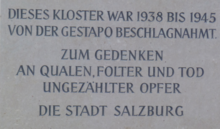Franciscan monastery Salzburg
The Franziskanerkloster Salzburg is located in the Franziskanergasse in Salzburg in Austria . The Franciscan Church is part of the branch .
history
In the fight against Protestantism , on the advice of Auxiliary Bishop and later Archbishop Georg von Kuenburg , Archbishop Johann Jakob von Kuen-Belasy (1560–1586) appointed Franciscans from the Upper German Province (Strasbourg Province) to Salzburg in 1583 . They received the just repealed monastery of St. Peter's (Benedictines) as a branch, which they moved into on November 7th.
Archbishop Wolf Dietrich von Raitenau gave the church its first Baroque transformation (1587–1612). The monastery was raised by one floor, the monastery garden and the connecting passage across the street were built. In 1635 the former parish church became a monastery church. In the 18th century, the baroque style of the church continued, so that from then on the monastery essentially had its present form. In addition to foundations, the Franciscan monastery in Salzburg also receives the so-called court alms. For the maintenance of St. Peter , the Franciscan Brothers take on various church services, funeral offices, and soul offices. The brothers appointed to pastoral care are well-known preachers in the Franciscan Church and in the cathedral, confessors, theological advisers and catechists. Soon the church became a center of popular piety. The cultivation of science and the study of theology - the monastery maintained its own university facility until 1781 - is also devoted to intensive care.
At the end of the 18th century, the Enlightenment and especially the Prince Archbishop Hieronymus Colloredo hard hit the monastery. A number of prohibitions restrict the life and work of the Franciscans in Salzburg. From December 1800 the French used the monastery as a barracks for three months and the church became a prison camp. In 1805, Marshal Jean-Baptiste Bernadotte occupied almost every room in the monastery and also demanded a tribute in food for the 300 soldiers housed. During this difficult time the Salzburg Franciscans found a friend in Ferdinand of Tuscany , the new sovereign prince (1803-1805) and brother of Emperor Franz II. He made the Franciscan Church his court parish, Italian sermons were introduced.

At the Congress of Vienna in 1815, the city of Salzburg and most of the archbishopric were again granted to Austria. The continuation of the Salzburg Franciscan monastery is secured by the union with the Tyrolean Province in 1818. In this way, over time, the personnel problems can be overcome and the pastoral work can be resumed. In the 19th century, the Salzburg monastery also houses the novitiate of the Franciscans, with the well-known musician Father Peter Singer working as the novice master for many years .
The annexation of Austria to Germany in 1938 threatened the existence of the monastery. The Franciscan monastery is the first to be lifted in Salzburg. The Gestapo moved into the monastery and parts of the building were used as a prison. Some of the brothers initially found a home in St. Peter's Abbey , until this was also confiscated. However, the Franciscan Church will not be closed and will be looked after by some brothers who are now living in the city.
In 1945 the American occupation forces moved into the monastery and installed the radio station Red-White-Red. The Salzburg regional studio of the ORF remains in these rooms until 1973. After the Salzburg State Studio had moved, the monastery complex was renovated between 1974 and 1977.
Today around 10 confreres live in the Franciscan Monastery of Salzburg, who exercise pastoral care at the Franciscan Church and are active in the hospital pastoral work.
Since October 2007 the monastery has also been home to the Provincialate of the Franciscan Province of Austria for St. Leopold , which includes Austria and South Tyrol.
Franciscan monastery and archaeological find areas are under monument protection , as is the church.
Church music
The services in the Franciscan Church are known for their musical design under the direction of Bernhard Gfrerer. Organ concerts take place regularly in the Gothic style church. Since November 8th, 2003 the Franciscan Church has had a new main organ , built by the Swiss organ builder A. Metzler .
literature
- Christoph Brandhuber and Oliver Ruggenthaler OFM: The worldview of a church prince as reflected in the image program of the “Dietrichsruh” - Wolf Dietrich's lost paradise , in: Center of Power. The art collections of the Salzburg prince archbishops: paintings / graphics / applied arts, ed. by Roswitha Juffinger, Salzburg 2011, pp. 394–509.
- Christoph Brandhuber and Oliver Ruggenthaler OFM: Wolf Dietrich and the Franziskaner - A Court Monastery for the Salzburg Residence , in: Strategies of Power. Court and residence in Salzburg around 1600 - architecture, representation and administration under Prince Archbishop Wolf Dietrich von Raitenau 1587 to 1611/12, ed. by Gerhard Ammerer and Ingonda Hannesschläger, Salzburg 2011, pp. 231–272.
- Florentin Nothegger: Salzburg - Franciscan Observant Monastery (with Nekrologium) , in: Alemania Franciscana Antiqua IV, pp. 75–164.
- Carena Sangl: On music practice in the Franciscan monastery in Salzburg in the 2nd half of the 18th century. In: Austria Franciscana No. 5 (2010), pp. 134–149. [1]
Web links
Individual evidence
-
↑ PM Schellhorn: The Petersfrauen. In: Mitt. D. Sbg. Ges. F. Regional Studies 65, 1925, S, 113-208.
Chr. Greinz: The prince-archbishop's curia and the city dean of Salzburg. Salzburg 1929, p. 229 f. - ↑ Franziskanerkloster Salzburg - Geschichte ( Memento of the original from October 13, 2015 in the Internet Archive ) Info: The archive link was inserted automatically and has not yet been checked. Please check the original and archive link according to the instructions and then remove this notice. . Retrieved October 13, 2015.
Coordinates: 47 ° 47 '52 " N , 13 ° 2' 38" E

